Vallisneria is the least demanding tank plant in terms of care. Except the fact that little effort is required for keeping it, the plant easily propagates as well. All in all, this is a perfect plant for beginners. Vallisneria species are popular choices for aquariums and provide numerous benefits, including oxygenation, water filtration, and aesthetics. These submerged plants typically have long, narrow leaves that can vary in color, size, and shape depending on the species. Vallisneria is known for its ability to propagate through runners and can form dense stands in aquatic environments. It is a versatile plant that can thrive in a wide range of water conditions, making it suitable for both beginner and experienced aquarists.
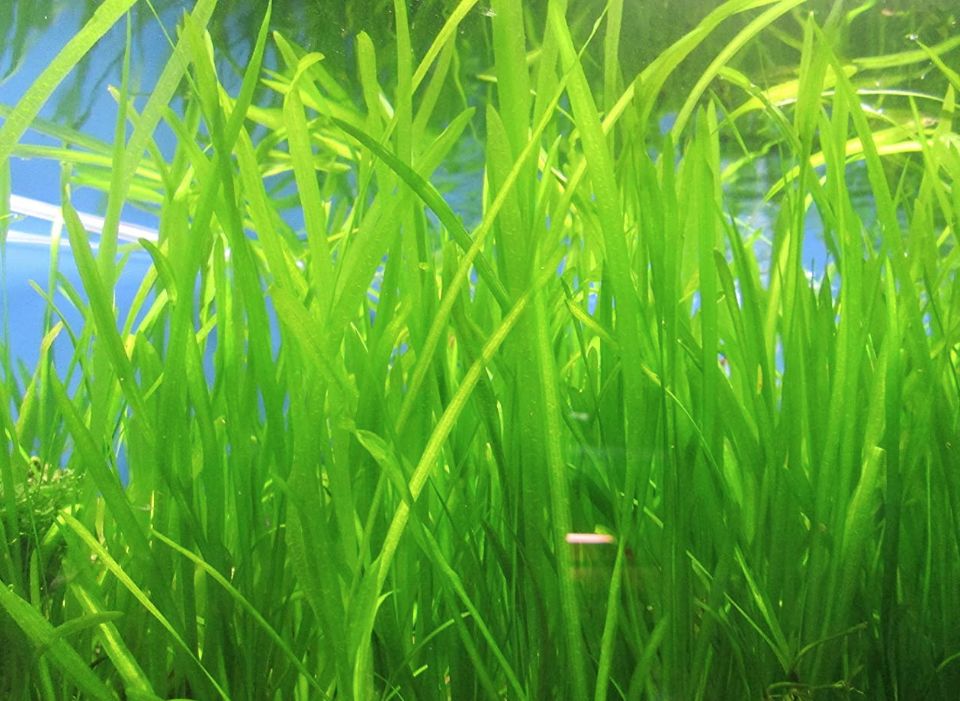
Contents
Plant Habitat in the wild
Genus includes only true aquatic plants (hydrophytes), which are ideally adapted for living in water. It got its name in honor of Italian naturalist Antonio Vallisneri. Antonio Vallisneri (1661-1730) was an Italian physician, naturalist, and botanist. He made significant contributions to the field of botany and is particularly known for his studies on plant anatomy, classification, and reproductive processes. Vallisneri’s work played a crucial role in the development of modern botany and he is considered one of the leading botanists of his time.
The plant is spread in freshwater basins of tropics and subtropics of Western and Eastern hemispheres and some species have expanded to moderate climate area. Vallisneria species are distributed worldwide and can be found in various regions, including Europe, Asia, Africa, Australia, and the Americas. In the wild species grow in freshwater ponds with lentic and lotic water about 1 m deep under water and form thick vegetation.
Vallisneria plants typically grow in submerged conditions, rooted in the sediment of lakes, ponds, rivers, and streams. They have long, ribbon-like leaves that grow from a central base and reach the water’s surface. These leaves can vary in width, length, and texture depending on the species and environmental conditions
Description
Genus encloses many various plants of this kind growing all around the globe. Some of them successfully grow in tanks. We’ll describe them in details below.
Unfortunately, their commercial names don’t coincide with scientific ones and quite often one and the same plant is sold labeled with completely different names. Besides, appearance depends on its growing conditions and for this reason its appearance may vary greatly.
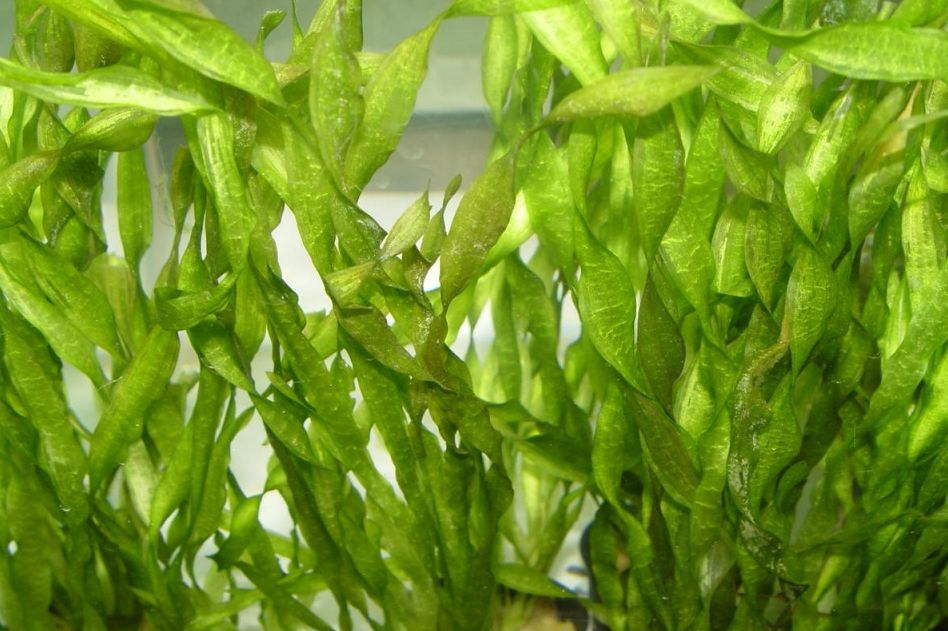
types of vallisneria
Vallisneria spiralis
Also known as straight vallisneria or straight tape grass, it is one of the most common and widely available species. It has long, straight leaves that can reach the water’s surface.
When speaking about most of aquarium hobby fans mean Vallisneria spiralis with ribbonlike bright green leaves. However, the species got its name not due to its curved leaves, but because of its spiral shaped floral stem. This is the most widespread aquarium plant and definitely the most popular one among species.
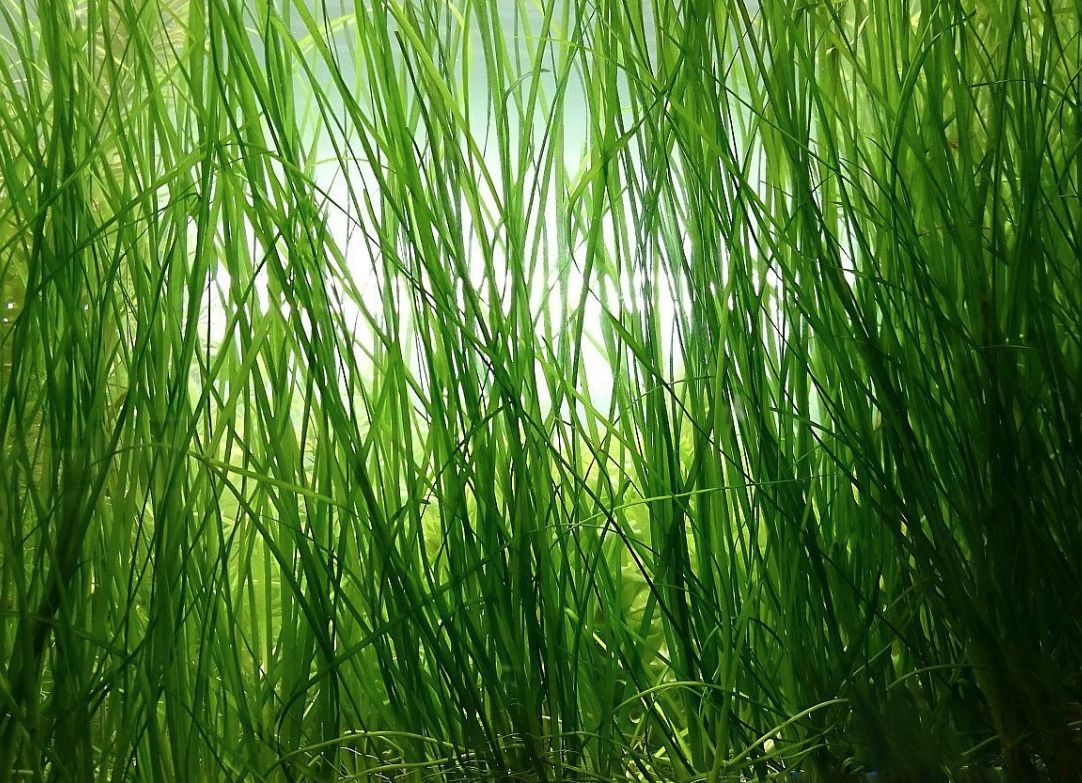
| Characteristic | Description |
|---|---|
| Common Name | Straight Vallisneria, Straight Tape Grass |
| Scientific Name | Vallisneria spiralis |
| Leaf Shape | Long, straight, ribbon-like leaves |
| Leaf Color | Green |
| Growth Habit | Submerged aquatic plant |
| Height | Can reach up to 1-2 feet (30-60 cm) |
| Width | Leaves can be 0.2-0.5 inches (0.5-1.2 cm) wide |
| Growth Rate | Moderate to fast |
| Light Requirement | Moderate to high |
| CO2 Requirement | Low |
| Water Temperature | 68-82°F (20-28°C) |
| pH Range | 6.5-8.5 |
| Water Hardiness | Can tolerate a range of water hardness levels |
| Propagation | Runners, lateral shoots |
| Difficulty Level | Easy |
| Suitable for Aquariums | Yes |
| Suitable for Ponds | Yes |
Vallisneria americana
Native to North America, it is commonly known as American eelgrass and is often used in aquariums and ponds. This species is distinguished by its unusual curved narrow leaves about 3-5 mm wide and up to 30 cm long. Such an appearance gave the name to the plant – Vallisneria corkscrew. It grows fast, propagates by growing runners which are a tiny copy of the parent plant. This plant has been known in aquarium hobby since 1991, when Dennerle company first brought it to Germany.

| Characteristic | Description |
|---|---|
| Common Name | Jungle Val, Wild Celery, Tape Grass, Eel Grass |
| Scientific Name | Vallisneria americana |
| Leaf Shape | Long, narrow, twisted shape leaves |
| Leaf Color | Green |
| Growth Habit | Submerged aquatic plant |
| Height | Can reach up to 8-12″ (up to 30 cm) |
| Width | Leaves can be 0.1-0.3 inches (0.3-0.8 cm) wide |
| Growth Rate | Moderate to fast |
| Light Requirement | Moderate to high |
| CO2 Requirement | Low |
| Water Temperature | 68-82°F (20-28°C) |
| pH Range | 6.5-8.5 |
| Water Hardiness | Can tolerate a range of water hardness levels |
| Propagation | Runners, lateral shoots |
| Difficulty Level | Easy |
| Suitable for Aquariums | Yes |
| Suitable for Ponds | Yes |
Vallisneria gigantea
This species is characterized by its large size and broad leaves. It is commonly found in tropical regions of Asia and Australia. This is a large plant with linear leaves of bright or dark green color that grow more than 50 cm long. You should keep Vallisneria gigantea in a large sized tank.
The Vallisneria gigantea is comparatively undemanding, but due to its large size it is seldom kept in home aquariums. It grows uniformly the whole year round. The plant is valued by fans of large fishes since it is undemanding, it looks great against their background as well as successfully withstands the fishes attacks.
Tank illumination should be rather bright. You should keep in mind that long leaves of this species create shadow for shorter plants that grow below. That’s why except intense overhead lighting you should install additional lateral illumination in the tank.
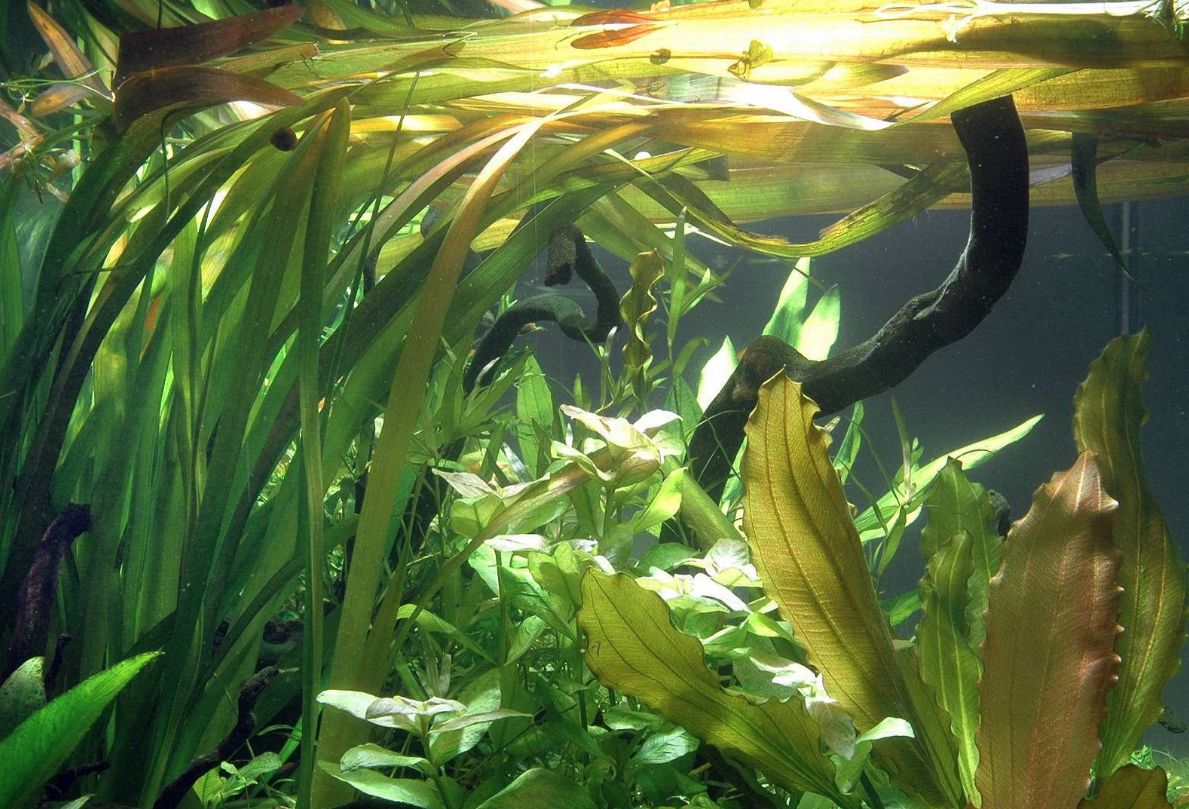
| Characteristic | Description |
|---|---|
| Common Name | Giant Vallisneria |
| Scientific Name | Vallisneria gigantea |
| Leaf Shape | Long, broad, strap-like leaves |
| Leaf Color | Green |
| Growth Habit | Submerged aquatic plant |
| Height | Can reach up to 20 inches (50 cm) |
| Width | Leaves can be 0.6 inch (1.5) wide |
| Growth Rate | Moderate to fast |
| Light Requirement | Moderate to high |
| CO2 Requirement | Low |
| Water Temperature | 68-82°F (20-28°C) |
| pH Range | 6.5-8.5 |
| Water Hardiness | Can tolerate a range of water hardness levels |
| Propagation | Runners, lateral shoots |
| Difficulty Level | Easy |
| Suitable for Aquariums | Yes |
| Suitable for Ponds | Yes |
Vallisneria nana
Also known as dwarf vallisneria, it is a variant of Vallisneria with thin leaves, grass-like type of Vallisneria that looks more like a tall hairgrass than the other usual types. It is suitable for smaller aquariums or foreground planting.
This is a relatively new plant in aquarium hobby. It originates from Central/South America. In the wild it grows just 30 cm long, which compared to other species isn’t long at all. That’s why the plant got the name ‘nana’.
The plant has light green leaves resembling ribbons in their appearance. It grows fast and forms a lot of runners. If you put Vallisneria nana in the background, soon you will get a solid green curtain there.
The plant is easy to keep and undemanding in terms of tank conditions. Nevertheless, it is recommended to add liquid fertilizers rich in iron and additionally supply CO2 into the tank. In this case the plant leaves gain saturated emerald green color.

| Characteristic | Description |
|---|---|
| Common Name | Vals Nana |
| Scientific Name | Vallisneria nana |
| Leaf Shape | Long, narrow leaves |
| Leaf Color | Green |
| Growth Habit | Submerged aquatic plant |
| Height | Typically grows up to 6-12 inches (15-30 cm) |
| Width | Leaves can be 0.2-0.4 inches (0.5-1 cm) wide |
| Growth Rate | Moderate |
| Light Requirement | Moderate to high |
| CO2 Requirement | Moderate |
| Water Temperature | 68-82°F (20-28°C) |
| pH Range | 6.5-8.5 |
| Water Hardiness | Can tolerate a range of water hardness levels |
| Propagation | Runners, lateral shoots |
| Difficulty Level | Easy |
| Suitable for Aquariums | Yes |
| Suitable for Ponds | Yes |
Difficulties in keeping
In general, vallisneria is a universal, easy to cultivate, rather undemanding plant, taking care about which will hardly ever cause any trouble even among beginner aquarists. The plant easily stands quite a wide range of tank conditions and temperature variations from 16 to 30 C. It doesn’t require special fertilizers, since naturally silted substrate is enough for it.
After replanting vallisneria into a new tank, give it some time for adaptation. It stops growing and propagating. However, 1-2 months later the plant starts growing fast. It propagates by growing runners with a bud at the end of each and a new plant quickly develops from it. Provided with favorable conditions vallisneria propagates very fast and in a short period of time it can take over the whole tank.
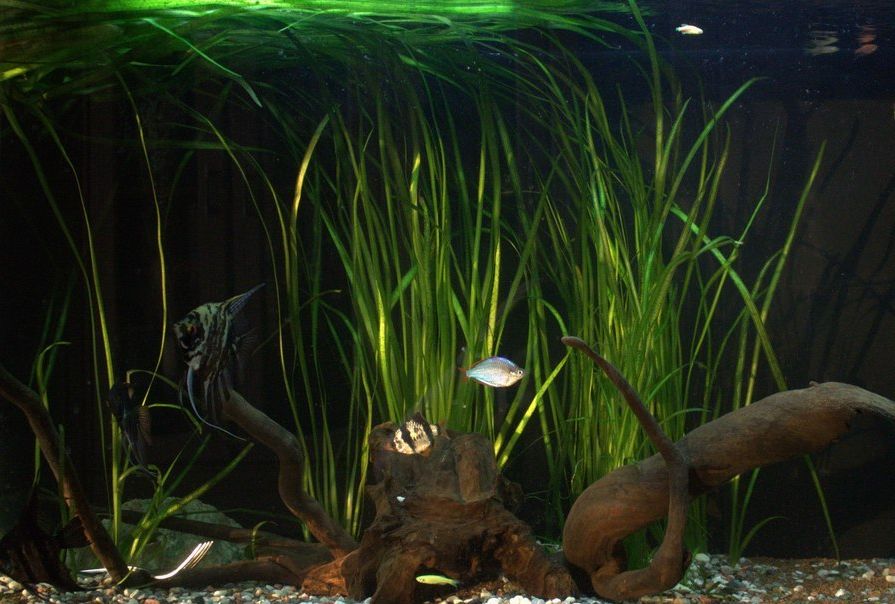
How fast does vallisneria grow?
The growth rate of Vallisneria can vary depending on various factors such as environmental conditions, lighting, nutrient availability, and the specific species or cultivar. However, Vallisneria is generally known for its moderate to fast growth rate under suitable conditions.
In optimal conditions with adequate lighting, nutrient-rich substrate or water column fertilization, and proper CO2 levels, Vallisneria can exhibit rapid growth. It can send out runners and produce new lateral shoots, allowing the plant to spread and form dense stands or meadows.
Under ideal circumstances, Vallisneria can grow several inches or more per week, extending its leaves toward the water’s surface. It’s not uncommon for Vallisneria plants to reach heights of 1 feet or more, depending on the species. However, growth rates can vary between different Vallisneria species and even within the same species depending on individual plant health and conditions.
Care and keeping in a tank
The plants are put in a group in the background or in the middle, or in the corner of a tank as well. The wider and longer the tank is, the more comfortable it is for the plant. At that the height of the tank isn’t a constraining factor, since light absorbing property of water doesn’t have high impact on species growth.
But you shouldn’t cut its leaves, which is often done by beginners. Plant is rather enduring, but after you do this, its leaves start to turn yellow and rot at the point where they were cut.
Light requirements
Vallisneria has moderate to high light requirements. While it can tolerate lower light conditions, providing it with sufficient light will promote healthier growth and more robust leaves. Adequate lighting ensures that the plant can carry out photosynthesis effectively, which is crucial for its overall development.
Like most of higher plants, these species prefer bright light, though in case of lack of light, they won’t die and continue developing, but at a slower pace. If you want to select light intensity particularly for species, it’s better to do it in an experimental way – from maximal possible lighting level for the current tank (it is about lamps wattage and duration of their working time) to the minimal lighting level, when the plants stop growing completely.
Temperature
All species grow at wide temperature range, that’s why you can grow them both in tropical tanks and those without heating. Lower temperature limit for most plants is 15 °C, tropical species are exception in this case. These are most of pygmy species that stop growing when the temperature is just 18-20 °C. In general vallisneria is undemanding and it can be recommended for beginner aquarists.
It’s important to note that different species or varieties of Vallisneria may have slightly different temperature preferences. Some species may be more tolerant of cooler temperatures, while others may prefer warmer conditions. Additionally, specific adaptations to local environments can influence the temperature tolerance of Vallisneria populations in the wild.
Water parameters
In the wild these plants grow in a very much wider range of hydrochemical parameters. The water parameters preferred by Vallisneria can vary slightly depending on the specific species or variety, but generally, they can tolerate a range of water conditions.
Most of species including tropical ones prefer water of medium hardness with neutral or slightly acidic pH. Vallisneria can tolerate a pH range of 6.5-8.5. It is adaptable to a slightly acidic to slightly alkaline environment. However, keeping the pH around neutral (7.0) is generally recommended for optimal growth.
Vallisneria is adaptable to a wide range of water hardness levels. They can tolerate both soft and hard water conditions. The general range for water hardness, measured in degrees of hardness (dH), is between 2-20 dH.
Only very acidic (pH less than 5) and very soft water (dGH less than 4°) isn’t good for the plant, since in such medium vallisneria quickly dies because potassium in its tissues gets dissolved.
CO2
While Vallisneria can thrive in aquariums without supplemental CO2 injection, providing moderate to high levels of CO2 can enhance their growth and overall health. CO2 supplementation can be beneficial, especially in heavily planted aquariums or if you aim to achieve faster growth rates.
Substrate
Type of bottom substrate, its thickness and how silted it is, isn’t important for the plant. Vallisneria has long roots that can extend deep into the substrate. It is recommended to have a substrate depth of at least 2-3 inches (5-7.5 cm) to provide sufficient anchoring and room for root development.
Vallisneria can grow in substrates with various grain sizes, but a medium to fine-grained substrate is often preferred. Finer substrates allow the roots to anchor more securely and make it easier for runners to spread throughout the substrate.
Vallisneria can benefit from a nutrient-rich substrate. Consider using a substrate specifically designed for planted aquariums, which often contain essential nutrients like iron and trace elements that promote healthy plant growth. Alternatively, you can incorporate root tabs or nutrient-rich additives into the substrate to provide additional nutrients.
Nutrients
As a rule it doesn’t require additional fertilization and natural silting of the substrate has enough nutrients for it.
We should mention one more peculiarity of this plant: it reacts adversely to copper excess in water. This chemical element can get into a tank as a component of substances used against algae or shell-fish in a tank. Some of other drugs often contain cupric sulphate, that’s why if you decide to cure your fish in a tank with vallisneria in it, the latter may die. The plant can also die because of iron oxide (rust) presence in the tank water.
how to propagate vallisneria
Vallisneria propagates very good. You can get over fifty bulbils from one parent plant in a year. These species never have any problems with propagation. The easiest way of propagation in a tank is a vegetative one.
Daughter bushes form from runners that grow from the rosette base of the parent plant. New plants are 5-10 cm away from the parent one and once they strike roots, they grow their own runners. As a result you get a whole cascade from large number of young bushes.
These young plants can be separated from a parent plant once they have 3-4 leaves about 6-8 cm long. But even if you don’t do this, the runner connecting the new and the parent plant will die off itself later.
Bushes usually don’t require weeding. It is needed only if the latter create shadow for other tank plants. In a tank plant develops uniformly during the whole year round. It doesn’t have visible dormant period, but the growth rate may vary. At that it is possible, that after relatively long period of active vegetation the plant suddenly stops growing. Such a situation should be considered as a norm, since, as a rule, several weeks later the plant continues growing.
From time to time parent plants die, since bush lifespan is about 2-3 years. In general, this loss is almost noteless, since it is more than outweighed by the number of young bushes.
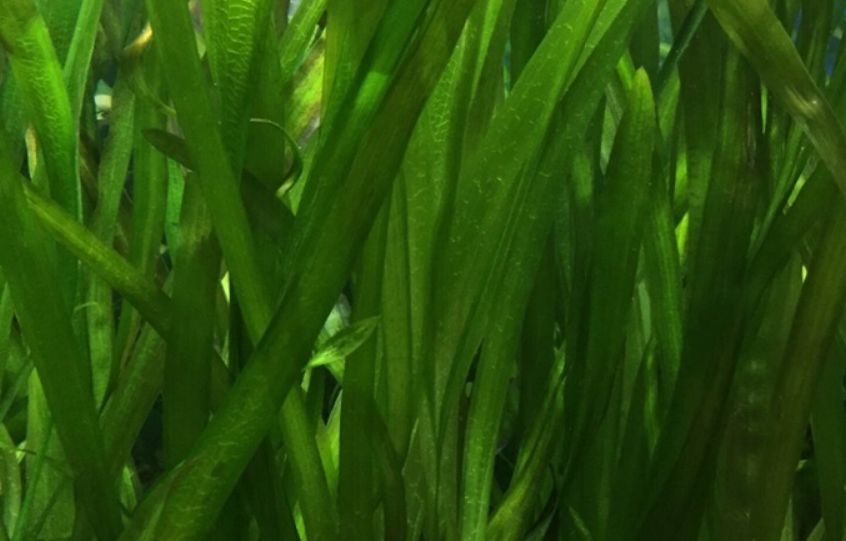
Compatibility
Vast majority of tank fishes don’t demonstrate any interest towards leaves, because most representatives of this genus have rather coarse leaves. This is true both for large species of armored catfishes and for herbivorous cichlids.
Bottom digging fishes are the only ones who can damage plants, because they easily pull out from the substrate the bushes you have planted.
However, ornamental aquarium snails are those who love vallisneria. They gladly crawl on its leaves without doing any harm to the latter.
Besides, thickly growing bushes are a shelter for both fish juveniles and small shrimps. Very often, these bushes are the shelter for the whole generations of the juveniles and shrimps.
Sources:
- https://en.wikipedia.org/wiki/Vallisneria
- https://dennerleplants.com/en/plants/plantdetails/Vallisneria-nana-(386)/27938
- https://www.researchgate.net/publication/233615258_Systematics_of_Vallisneria_Hydrocharitaceae
- https://www.journals.uchicago.edu/doi/pdf/10.1086/331983
- https://www.mdpi.com/2073-4441/14/14/2236/pdf